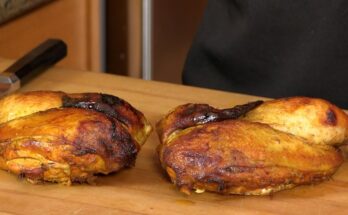Ooni Pizza Dough Recipe: Nothing beats a perfectly crispy, chewy, and bubbly pizza straight from your Ooni oven—but great pizza starts with great dough. Whether you’re using an Ooni Koda, Karu, or Fyra, the right dough makes all the difference.
In this step-by-step guide, we’ll dive deep into creating the ultimate Ooni pizza dough that holds up to the heat and delivers restaurant-quality results in your backyard.
Introduction to Ooni Pizza Dough
Ooni ovens are designed to reach blazing high temperatures—often over 900°F—which mimics the conditions of a traditional wood-fired oven. These high temperatures mean your pizza cooks in just 60–90 seconds, creating a beautifully leopard-spotted crust with a soft, airy interior.
But not just any dough can handle that kind of heat. Ooni dough needs to be stretchy yet strong, moist but not soggy, and light while still flavorful. That’s why crafting the right dough recipe tailored for Ooni’s high-heat performance is crucial. The beauty of this recipe is in its simplicity, yet the results are out-of-this-world when done right.
Let’s get into what you’ll need to start this pizza party off right.
Ingredients Needed
Creating the perfect Ooni dough starts with just a few high-quality ingredients. Here’s what you’ll need:
Basic Ingredients
- Flour – 500g (preferably 00 flour or bread flour)
- Water – 325ml (65% hydration)
- Salt – 10g
- Dry Yeast – 1g (or 3g of fresh yeast)
These four ingredients are the heart and soul of Neapolitan-style pizza dough. For Ooni ovens, 00 flour is ideal due to its fine texture and high protein content. It allows the dough to stretch easily without tearing, perfect for those ultra-thin yet crispy crusts.
Optional Flavor Enhancers
- Olive oil – 1 tbsp (optional, for softer texture)
- Sugar – ½ tsp (helps with browning and fermentation)
- Malted barley flour – 1 tbsp (aids in crust color and crispness)
While not required, these additions can give your dough a more complex flavor profile and improve texture—especially if you’re experimenting with different styles.
Tools and Equipment
Before diving into the dough-making process, having the right tools can make a world of difference. You don’t need a full-blown pizzeria setup, but a few key items are worth having:
Essential Tools
- Digital scale – Precision is crucial in baking; always weigh your ingredients.
- Mixing bowl – Preferably large and stainless steel or glass.
- Measuring cups/spoons – For optional ingredients and water.
- Plastic scraper or bench knife – For shaping and dividing dough.
Optional But Helpful Tools
- Stand mixer – Saves time and energy when kneading.
- Dough proofing box – Keeps your dough balls organized and airtight.
- Pizza peel – For transferring pizza into the Ooni oven.
- Infrared thermometer – To check the oven surface temperature.
- Pizza stone or baking steel – For use with other ovens, helps simulate Ooni heat.
While you can definitely get by with just the basics, investing in a few of these tools can make the process smoother and more enjoyable. Plus, they’ll help you get more consistent results over time.
Understanding the Science of Pizza Dough
Before jumping into the recipe, it helps to understand the why behind each step. Pizza dough is more than just mixing flour and water—it’s a delicate balance of hydration, fermentation, and gluten development.
Gluten and Hydration
Gluten is the protein network that gives dough its stretchiness. The more you knead and ferment the dough, the more developed the gluten becomes, allowing you to stretch the dough thin without tearing. Hydration (the ratio of water to flour) impacts how light and airy the crust becomes. For Ooni, 65–70% hydration is ideal—it helps achieve that charred, bubbly, soft-yet-crispy texture.
Fermentation and Flavor
Fermentation isn’t just for rise—it’s also where flavor is built. A slow, cold fermentation (typically 24–72 hours in the fridge) allows enzymes to break down starches into sugars, creating a more complex, slightly tangy flavor profile. This also improves dough extensibility, making it easier to stretch thin for cooking in the Ooni.
Ooni-Specific Considerations
Because Ooni ovens cook pizza so quickly, you want a dough that cooks evenly without burning or becoming raw in the middle. That’s why a high-hydration, well-fermented dough is your best bet. It ensures your crust puffs quickly, chars just enough, and remains chewy inside—all in under 90 seconds.
Step-by-Step Ooni Pizza Dough Recipe
Crafting dough for your Ooni oven isn’t complicated—but it does require precision, patience, and a little love. Follow these detailed steps to make pizza dough that’s light, chewy, and perfect for blistering-hot bakes.
Step 1 – Mixing the Dough
Start by measuring all your ingredients using a digital scale. Precision is key. In a large mixing bowl, add your flour first. Then dissolve the yeast in room-temperature water and slowly pour it into the flour while mixing with your hand or a wooden spoon. Mix until a shaggy, sticky dough forms.
Avoid dumping everything in at once. Add the water gradually while mixing to help the flour absorb it evenly. Once the water and flour come together, sprinkle the salt on top and mix it into the dough. If you’re using olive oil or sugar, this is the time to add them.
You don’t want a perfectly smooth dough at this stage—just combined enough that no dry flour remains. Let the dough rest uncovered for 20–30 minutes to allow the flour to fully hydrate (this is called “autolyse” and helps develop gluten later).
Step 2 – Kneading the Dough
After the rest, knead the dough until it becomes smooth and elastic. If kneading by hand, use a push-pull motion on a clean surface. It should take around 10–12 minutes of active kneading. If you’re using a stand mixer with a dough hook, knead on low speed for about 8 minutes.
You’ll know the dough is ready when it’s smooth, bounces back when poked, and doesn’t stick excessively to your hands. The “windowpane test” is helpful here: stretch a piece of dough—if you can see light through it without it tearing, it’s ready.
Don’t over-knead! This can make your dough too tight and hard to stretch later. If the dough feels too sticky, resist the urge to add more flour—just keep kneading or let it rest for a few minutes before continuing.
Step 3 – First Fermentation (Bulk Rise)
Transfer the kneaded dough to a clean bowl lightly coated with olive oil. Cover it with a damp cloth or plastic wrap and let it rest at room temperature (around 70–75°F or 21–24°C) for about 2–3 hours. This is the bulk fermentation stage where the dough rises and develops initial flavor.
You’re looking for a dough that roughly doubles in size. If your room is cold, this could take longer. If warm, keep an eye on it so it doesn’t overproof.
At this stage, gluten continues to develop naturally, and the yeast starts releasing gas, making the dough airy and light. Don’t rush this part—it’s crucial for flavor and structure.
Once it’s risen, punch it down gently to release the gas. It’s now ready to divide into pizza portions.
Step 4 – Dividing and Balling the Dough
Turn the dough out onto a clean surface and divide it into equal portions. For Ooni-style pizzas (10–12 inches), 240g–260g dough balls work great. Use a bench scraper to divide, and weigh each ball for consistency.
To shape, take one portion and gently tuck the edges underneath, rotating as you go, until you form a smooth, tight ball. The top should be taut and the bottom sealed.
Place each dough ball in a lightly oiled container or dough proofing box. Cover and let rest for 30–60 minutes at room temperature before moving to the fridge for cold fermentation. If you’re making pizza the same day, you can let them rest for 3–4 hours at room temp instead—but cold fermenting is always better.
Step 5 – Cold Fermentation
This step is the secret sauce to amazing pizza. Cold fermentation slows down yeast activity, allowing enzymes to work their magic, breaking down starches into sugars and developing rich, complex flavors.
Place the covered dough balls in the fridge and let them rest for at least 24 hours—48 or even 72 hours is ideal if you have the time. The longer you wait, the more flavorful your dough will become.
Make sure your containers are airtight or tightly covered to prevent the dough from drying out. During this time, the dough will expand slightly and become super soft, stretchy, and easy to work with.
When you’re ready to make pizza, take the dough out of the fridge 2–3 hours beforehand so it can come to room temperature and become pliable. Cold dough is hard to stretch and may tear, so don’t skip this warming-up period.
Preparing Dough for Cooking
Now that your dough is perfectly fermented, it’s showtime. But wait—don’t rush straight into shaping and baking. There’s a bit of prep work needed to ensure your pizza turns out like a wood-fired masterpiece.
Bringing Dough to Room Temperature
Cold dough is tough, literally. If you try to stretch it straight from the fridge, it’ll resist and possibly tear. Take your dough balls out and let them sit, covered, at room temperature for at least 2 hours. This resting period allows the gluten to relax and the dough to become supple and stretchy.
Stretching Techniques
Once the dough is at room temperature, flour your work surface and hands with a mix of semolina and flour. Gently turn the dough out without deflating it. Start by pressing the center and working outward, leaving about an inch of rim untouched for that glorious crust (or “cornicione”).
Then lift the dough and use the backs of your hands and knuckles to gently stretch it out to 10–12 inches. Avoid using a rolling pin—it pushes out all the air bubbles you worked so hard to create during fermentation.
If it resists, let it rest for 5 minutes and try again. Never force the stretch. The dough should be relaxed, airy, and easily take on the round shape you want.
Cooking Pizza in an Ooni Oven
Time to fire up your Ooni and turn that dough into pizza magic. One of the key differences with Ooni ovens is their high heat, and understanding how to manage it will make or break your pie.
Ideal Oven Temperature
Preheat your Ooni oven for 15–20 minutes until it reaches around 850–900°F (450–480°C) on the stone surface. Use an infrared thermometer to check this—accuracy here is vital. If your stone is too cold, the bottom won’t cook. Too hot, and you’ll burn it before the top finishes.
Launching and Rotating
Dust your pizza peel with semolina or flour. Place the stretched dough on the peel, top it quickly (less is more!), and give it a little shake to make sure it slides.
Launch it into the Ooni with a quick flick. Let it cook for about 20 seconds, then start rotating every 15 seconds to cook evenly. Total cook time is around 60–90 seconds.
Don’t walk away! These ovens are fast and intense. Keep your eye on the crust and rotate until you see those beautiful leopard spots.
Once done, let it rest for a minute, slice it up, and enjoy the fruits of your dough-labor.
Troubleshooting Common Dough Issues
Even experienced pizza makers hit bumps in the road. Here’s how to fix the most common Ooni dough problems:
Sticky Dough
If your dough is sticking too much:
- Use more flour or semolina on your peel and hands.
- Ensure the dough has warmed up enough before handling.
- Avoid over-hydration—stick to 65–68% hydration until you’re confident.
Dough Tearing
This usually happens when:
- The gluten network isn’t developed (knead more next time).
- You stretched the dough cold (let it rest).
- You rolled it too thin—press and stretch gently.
Burnt Bottoms or Undercooked Centers
- Too hot? Let your stone cool down a bit before the next pizza.
- Too cold? Preheat longer or use an IR thermometer to verify.
- Rotate the pizza every 15–20 seconds to prevent burning.
- Don’t overload with toppings; it leads to soggy centers.
Fixing these small issues will take your pizzas from “pretty good” to “pizzeria-perfect.”
Final Tips for Perfect Ooni Pizza Dough
Want to level up even more? These pro tips will refine your dough game:
Use High-Quality Flour
Try Italian Tipo 00 or Caputo flour. The fine grind and high protein content make it ideal for high-temp cooking.
Adjust Hydration for Season and Flour Type
In humid climates or when using higher-protein flours, you might reduce water slightly. In dry climates or with lower-protein flours, increase it a bit.
Rest is Best
Let the dough rest between each phase—after mixing, after kneading, and before stretching. This makes the dough easier to handle and gives better texture.
Flour the Peel Liberally
A sticky peel ruins everything. Use semolina for a smoother launch and less sticking.
Don’t Overdo the Toppings
A heavy hand leads to sogginess. Ooni pizzas cook fast, and too many toppings prevent even cooking. Keep it simple for the best results.
FAQs about Ooni Pizza Dough Recipe
What ingredients do I need for the Ooni pizza dough recipe?
To whip up your own Ooni pizza dough, you’ll need just a few basic ingredients: water, flour, salt, and yeast. Simple, right? It’s all about quality ingredients and precise measurements to get that perfect, puffy crust.
How long should I let the Ooni pizza dough rise?
Patience is key here! For the best results, let your dough rise for at least 24 hours in the fridge. This slow fermentation is the secret to a flavorful and airy crust. If you’re short on time, a minimum of 4-6 hours at room temperature will work in a pinch.
Can I use gluten-free flour for the Ooni pizza dough?
Absolutely! Ooni is all about inclusivity. Just swap in your favorite gluten-free flour blend in place of regular flour. Keep in mind, the texture might vary, but you’ll still get a delicious, crispy crust.
What’s the best temperature to cook pizza dough in an Ooni oven?
Crank it up! Ooni ovens are designed to reach temperatures of up to 950°F (500°C), which is ideal for cooking a pizza in just 60 seconds. Ensure your oven is hot enough for that quintessential charred crust and perfectly melted cheese.
How thin should I roll out my pizza dough for the best results in an Ooni oven?
Thin is in! For the ideal bake in an Ooni oven, roll your dough to about 1/4 inch thick. This ensures a crispy base and perfectly cooked toppings. Just make sure it’s not too thin in the center, or you might end up with a pizza mishap!
Is there a secret tip for the perfect Ooni pizza crust?
Yes, indeed! Before cooking, give your rolled-out dough a generous drizzle of olive oil for that golden, crispy finish. Also, don’t overload with toppings – less is more to allow the dough to cook through beautifully.
Conclusion
Mastering Ooni pizza dough isn’t just about following a recipe—it’s about understanding the process, tweaking based on feel, and practicing with each pie. Once you nail the balance of hydration, fermentation, and temperature, you’ll be pulling out pizzas that rival your favorite Neapolitan pizzeria.
From mixing and kneading to stretching and firing, every step plays a role in crafting the perfect crust. And remember—pizza making is a journey, not a race. Each batch gets better, so don’t be afraid to experiment and find your own dough zen.



